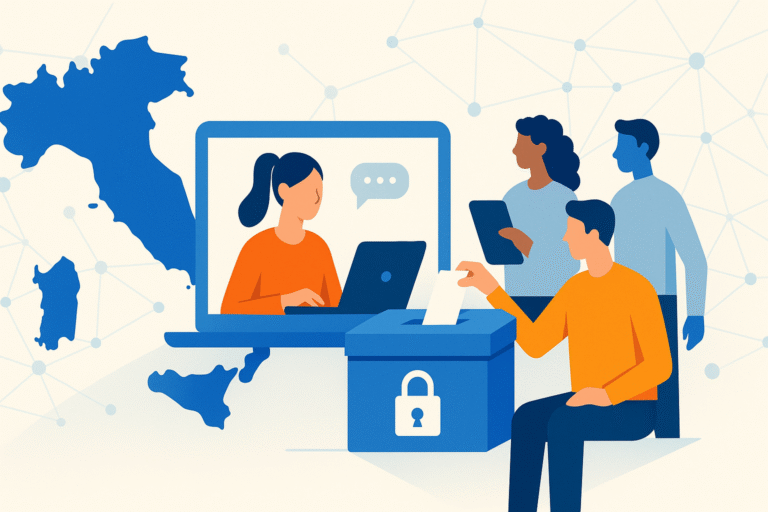
Introduction
In the global conversation around digital transformation of democracy, Estonia stands out as a pioneer. It was the first country in the world to implement nationwide online voting — and today, its i-Voting system, active since 2005, is considered one of the most mature and secure digital democracy experiences globally.
This article explores how the Estonian model works, why it’s internationally admired, and what lessons it can offer to other countries striving for more accessible and efficient participation processes.
👉 If you’re interested in related topics, also check out:
- How to Protect Data in Digital Voting Processes
- Digital ID and E-signatures for Participation
- AI and Public Decisions: Opportunities and Risks
Active for Nearly Two Decades
Estonia introduced online voting in 2005 for local elections. Since then, it has been used consistently in all major elections, including parliamentary and European elections. In 2023, over 50% of all votes were cast online.
Key Numbers:
- Over 300,000 digital ballots in 2023
- Voting access available in 150+ countries for Estonian citizens abroad
- 90% user satisfaction according to government surveys
👉 Source: Estonian Electoral Committee
How i-Voting Works in Estonia
i-Voting is built on Estonia’s solid digital infrastructure, which is also used for tax, health, and e-residency services.
The Main Steps:
- Digital Identification
Voters log in with their e-ID card, Mobile-ID, or Smart-ID using two-factor authentication. - Vote Casting
Voters download a secure app, choose their candidate, and digitally sign the ballot with their private key. The vote is encrypted locally and sent anonymously. - Verification
With a separate verification app, voters can confirm that their vote was recorded correctly. - Re-voting Option
Voters may re-cast their vote multiple times. Only the last valid vote is counted.
👉 The system is fully open-source: Estonian Voting System on GitHub
Security, Auditing, and Transparency
Contrary to common fears, Estonia shows that online voting can be safer than paper ballots, if implemented correctly.
- Votes are end-to-end encrypted
- All operations are logged in a public ledger for transparency
- Independent auditing is enabled by external experts, parties, and international observers
👉 Learn more in Smart Contracts and Decentralized Governance
Participation and Accessibility
Estonia’s digital voting experience stands out for its accessibility and inclusiveness:
- Citizens abroad can vote securely without traveling
- People with mobility issues can vote independently
- Younger generations are more engaged thanks to digital convenience
The i-Voting system helped reduce participation barriers, supported by public campaigns and digital literacy programs.
What Other Countries Can Learn
Although Estonia is small and highly digitized, its model offers powerful insights for many nations.
1. Build Reliable Digital Infrastructure
i-Voting requires a secure, universal digital ID system.
2. Ensure Transparency and Trust
Open-source software and auditability boost credibility.
3. Promote Digital Civic Education
Estonian citizens are trained and supported to use e-services confidently.
4. Start Small
Other countries could begin with local participatory processes like budget consultations or community votes.
5. Adapt to Local Context
Cultural, legal, and technological realities vary: each country must shape its own path.
🌍 International Examples to Watch:
- Switzerland: federal e-voting pilots since 2004
- Brazil: widespread use of digital voting machines
- Taiwan: civic consultations via the vTaiwan platform
- Spain (Barcelona): digital public decision-making using Decidim
👉 In Italy, platforms like Concorder are helping local communities adopt transparent, collaborative online decision-making.
Conclusion
The Estonian model proves that it’s possible to build a secure, verifiable, and inclusive online voting system. It’s not a one-size-fits-all solution, but it’s a clear opportunity to bring democracy into the digital age.
For other nations, the challenge is not just technical — it’s cultural and institutional. The Estonian example shows that with transparency, trust, and public investment, digital democracy can become a reality.
External Sources
- Estonian Electoral Committee
- E-Estonia – i-Voting Overview
- GitHub – Estonian Voting System
- OECD – Innovative Citizen Participation
- Nature – Legitimacy of Estonia’s i-Voting


